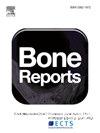大鼠创伤性肩关节模型的术后粘连研究
IF 2.6
Q3 ENDOCRINOLOGY & METABOLISM
引用次数: 0
摘要
三分之一的肱骨近端骨折切开复位钢板后患者需要随后取下钢板,主要原因是三角肌深表面与骨折固定区之间发生粘连,限制了肩部活动。采用肱骨近端骨折手术中常用的三角肌劈开入路,建立大鼠术后肩关节粘连模型,用直菱形鼻锉对三角肌下表面、冈上肌腱和毗邻的肱骨近端造成创伤。采用该模型,在创口闭合前注射仿海藻酸盐治疗12只动物的创伤肢和未治疗的9只动物分别固定9±1 d,测量其被动屈伸幅度,并进行组织病理学检查。海藻酸盐治疗组肩关节屈伸总被动范围为120度,大于未治疗组的84度(p = 0.0043)。未治疗组损伤区骨膜纤维化囊平均宽度(515±449 μm)大于海藻酸盐组(186±180 μm, p = 0.003)。未治疗的动物有严重的4级纤维化、胶原沉积和肉芽组织,而治疗的动物有轻度的1级反应。建立的动物模型产生有限的肩部运动和相关的纤维化改变。它可用于评估预防肱骨近端骨折钢板后粘连的潜在治疗方法。本文章由计算机程序翻译,如有差异,请以英文原文为准。
A rat traumatized shoulder model for the study of post-surgical adhesions
A third of patients after open reduction and plating of proximal humerus fractures require subsequent plate removal principally because of adhesions which occur between the deep surface of the deltoid and fracture fixation zone and limit shoulder motion. A rat model of post-surgical shoulder adhesions was developed using a deltoid split approach commonly used in proximal humerus fracture surgery, with trauma induced by a straight diamond nasal rasp to the undersurface of the deltoid and supraspinatus tendon and adjoining proximal humerus. Using the model, the traumatized limb of 12 animals treated with an alginate mimetic injected into the wound before closure and 9 untreated animals were immobilized for 9 ± 1 days and then their passive range of shoulder flexion-extension measured, followed by histopathology examination. The total passive range of shoulder flexion-extension of 120 degrees in the alginate treated group was greater than the 84 degrees in the untreated group (p = 0.0043). The mean periosteal fibrotic capsule width in the injured area of untreated animals (515 ± 449 μm) was greater than that of animals treated with alginate (186 ± 180 μm, p = 0.003). Untreated animals had severe, grade 4 fibrosis and collagen deposition, and granulation tissue, while treated animals had mild grade 1 responses. The animal model developed produced limited shoulder motion and associated fibrotic changes. It can be used to evaluate potential treatments designed to prevent adhesions that develop after plating of proximal humeral fractures.
求助全文
通过发布文献求助,成功后即可免费获取论文全文。
去求助
来源期刊

Bone Reports
Medicine-Orthopedics and Sports Medicine
CiteScore
4.30
自引率
4.00%
发文量
444
审稿时长
57 days
期刊介绍:
Bone Reports is an interdisciplinary forum for the rapid publication of Original Research Articles and Case Reports across basic, translational and clinical aspects of bone and mineral metabolism. The journal publishes papers that are scientifically sound, with the peer review process focused principally on verifying sound methodologies, and correct data analysis and interpretation. We welcome studies either replicating or failing to replicate a previous study, and null findings. We fulfil a critical and current need to enhance research by publishing reproducibility studies and null findings.
 求助内容:
求助内容: 应助结果提醒方式:
应助结果提醒方式:


